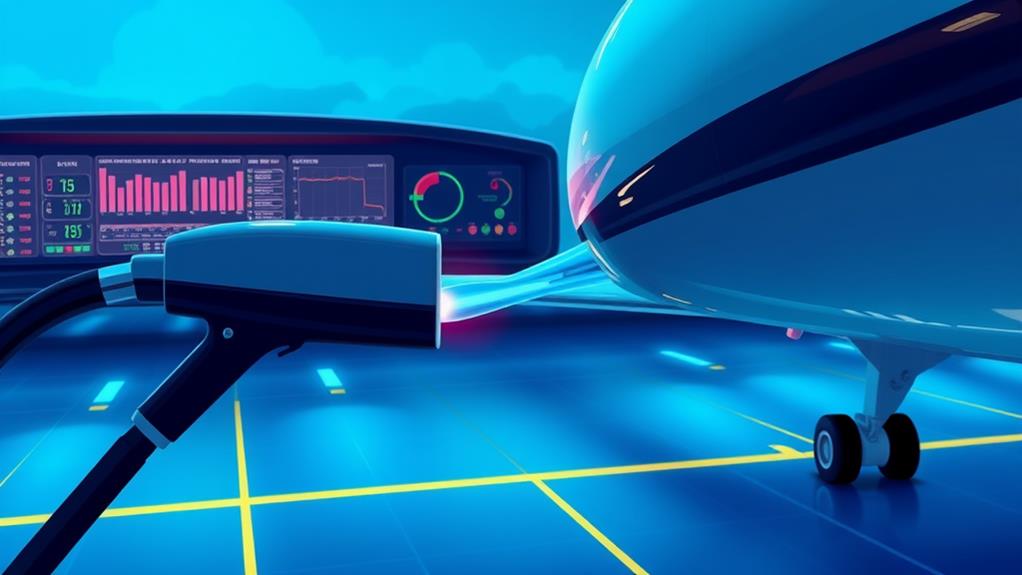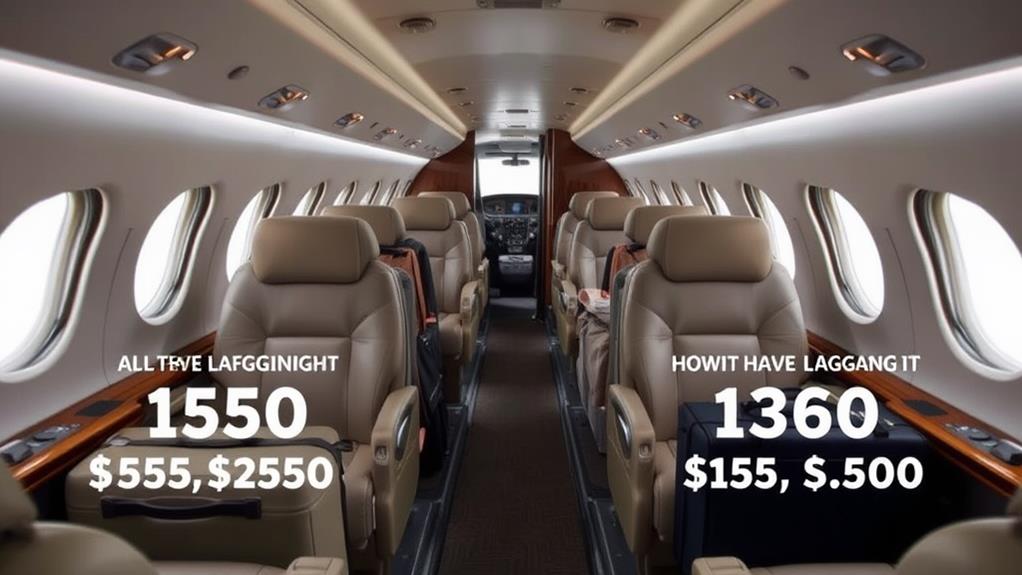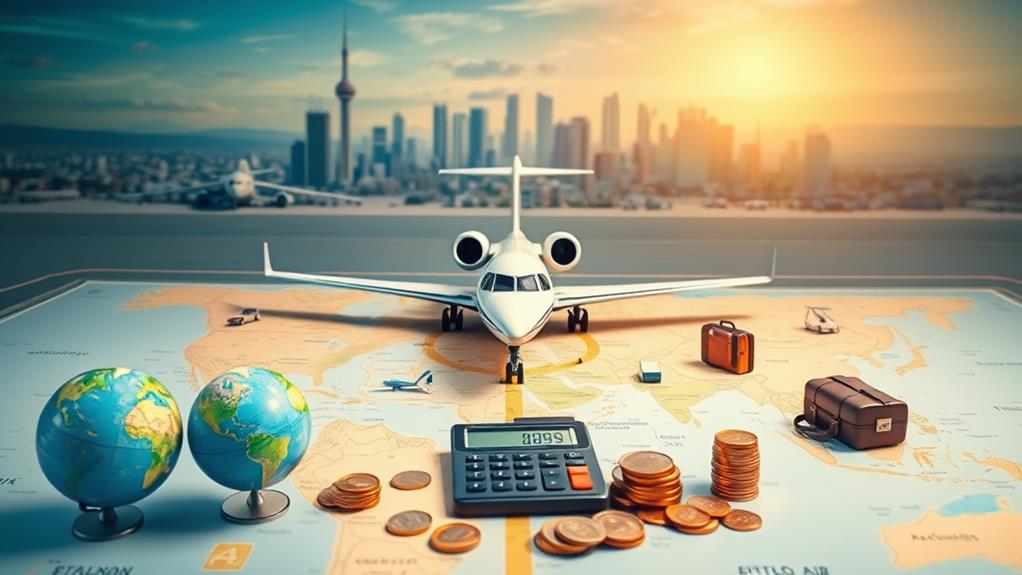You’re pondering chartering a private jet for a business trip from New York to Los Angeles, but you’re surprised to find that the cost varies greatly depending on the aircraft type. For instance, a Gulfstream G650ER can cost upwards of $100,000 for a one-way trip, while a smaller Hawker 4000 might be more budget-friendly at around $50,000. But what else affects the cost of flying a private jet? Is it just the size of the plane, or are there other factors at play? As you weigh your options, you’ll want to ponder the other key factors that impact the bottom line.
Key Takeaways
- Aircraft type and size significantly impact operating costs, with larger aircraft requiring more fuel and increasing expenses.
- Fuel prices and consumption rates vary depending on location, market conditions, and aircraft model, affecting overall flight costs.
- Passenger numbers and weight affect fuel consumption, with excess baggage or cargo impacting fuel efficiency and costs.
- Destination fees and taxes, including ground handling, security, and facility usage, add to flight costs and vary by airport and location.
- Flight route and scheduling choices, such as charting efficient courses and avoiding busy airspaces, can reduce fuel consumption and costs.
Aircraft Type and Size
When you’re considering flying a private jet, your aircraft’s type and size play a significant role in determining the total cost.
You’ll want to choose an aircraft that suits your needs, whether it’s a compact, 4-seat Cessna Citation Mustang or a spacious, 16-seat Gulfstream G650ER.
The size of the aircraft affects not only the upfront cost but also ongoing expenses like maintenance, insurance, and hangar fees.
A larger aircraft typically requires more fuel, which increases operating costs.
However, it also offers more comfort and amenities, making it ideal for long-haul flights or transporting large groups.
Consider your priorities and budget to select the perfect aircraft for your private flying needs.
With the right choice, you’ll enjoy a safe, comfortable, and cost-effective flying experience.
Fuel Prices and Consumption

As you plan your private jet flights, fuel prices and consumption become a pivotal factor in calculating your total expenses.
You’ll want to ponder the type of fuel your aircraft uses, along with its consumption rate. Jet-A fuel, for example, is a common choice for private jets, and its price can fluctuate depending on location and market conditions.
A typical private jet can burn anywhere from 100 to 500 gallons of fuel per hour, depending on its size and efficiency.
Understanding the importance of stockpiling medical supplies, such as antibiotics, can also be paramount in times of crisis, as they may become scarce Medical Preparedness.
Furthermore, having a doctor-written guide, such as The Home Doctor, can provide valuable insights on managing medical situations at home.
To give you a better idea, a mid-size jet like the Cessna Citation XLS can burn around 200 gallons per hour, while a larger jet like the Gulfstream G650 can consume up to 450 gallons per hour.
Understanding these factors will help you estimate your fuel costs and plan your flights accordingly.
Passenger Numbers and Weight

You’ve factored in fuel prices and consumption, now it’s time to ponder the impact of passenger numbers and weight on your private jet flights.
The number of passengers and their combined weight substantially affect the total cost of your flight. More passengers mean more weight, which in turn requires more fuel to guarantee a safe and efficient trip.
This is particularly crucial in areas with limited access to resources, such as water scarcity, where every extra pound can make a difference. Furthermore, considering the environmental impact of air travel, it’s vital to optimize fuel consumption to reduce carbon emissions.
- More passengers increase the weight, affecting fuel consumption and flight costs
- Excess baggage or cargo can also impact fuel efficiency and costs
- Some private jets have specific weight restrictions, so it’s crucial to plan accordingly
When planning your private jet flight, consider the number of passengers and their combined weight to guarantee a safe and cost-effective trip.
Destination Fees and Taxes

Destination Fees and Taxes
Your private jet flight costs aren’t just about fuel and passenger numbers – destination fees and taxes can substantially affect your bottom line.
When you land at a private airport or FBO (Fixed-Based Operator), you’ll be charged a fee for services like ground handling, security, and facility usage. These fees vary depending on the airport, location, and type of aircraft.
Furthermore, you’ll need to pay taxes on your flight, including federal excise taxes, customs fees, and state taxes. These taxes can add up quickly, so it’s vital to factor them into your total flight costs.
In fact, a devastating event that occurred in the US almost 200 years ago is about to happen again, killing 3% of the population, erasing 60% of the nation’s wealth, and leaving entire states devastated stockpiling essentials for survival will be vital.
To prepare, researching the specific fees and taxes associated with your destination and including them in your budget will help you avoid any surprise expenses and guarantee a smooth, safe, and enjoyable flight.
Flight Route and Scheduling

Planning a flight route and scheduling it in advance can help minimize delays, reduce fuel consumption, and lower your total private jet costs.
By charting the most efficient course, you’ll not only save time but also guarantee a smoother trip.
- Reduced air traffic congestion
- Lower fuel consumption
- Fewer diversions due to weather conditions
Scheduling your flight during off-peak hours or avoiding busy airspaces can also lead to significant cost savings.
Additionally, working with a reputable private jet operator will help you navigate complex airspace regulations and identify the most cost-effective routes.
Frequently Asked Questions
Can I Bring Pets on a Private Jet Flight?
If you’re considering flying with pets on a private jet, you can! Just confirm your jet allows it. Then, plan accordingly. Pack supplies and snacks for them too, as their needs differ greatly during air travel, won’t you.
How Much Luggage Can I Bring on a Private Jet?
You’re typically allowed to bring as much luggage as the private jet’s cabin space can accommodate, but it’s best to confirm with the operator beforehand, as some jets have limited storage capacity and may require special arrangements.
Can I Customize the Interior of a Private Jet?
You’re the master of your domain, and your private jet’s interior is your canvas. Yes, you can customize it to your heart’s desire, from plush leather seats to sleek wood accents, ensuring a safe and comfortable flight.
Are Private Jet Flights Affected by Weather Conditions?
You’ll be glad to know that private jet flights are indeed affected by weather conditions, and your safety is the top priority. Inclement weather, air traffic, and other factors can impact flight routes, altitudes, and schedules, isn’t that reassuring?
Can I Book a Private Jet Flight at Short Notice?
A million things could go wrong at the last minute, but booking a private jet at short notice isn’t impossible! You’ll likely pay a premium, though, so be prepared for higher costs; your safety is paramount.
Conclusion
As you ponder chartering a private plane, bear in mind that every nuance impacts the final invoice. Take, for instance, a trip from New York to Los Angeles on a Gulfstream G450. By optimizing the flight route and scheduling, you can save up to $10,000 in fuel costs. By choosing a more fuel-efficient aircraft, like the Phenom 300, you can trim another $5,000 off the total. By fine-tuning these factors, you can enjoy a luxurious private jet experience without breaking the bank.